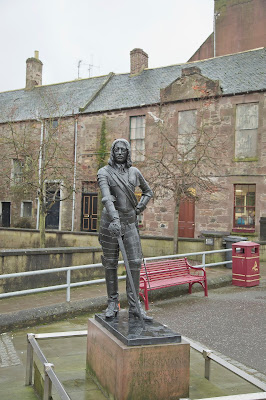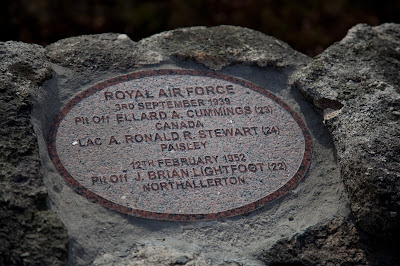ON THIS DAY IN 1638 – by Duncan Harley
James
Graham 1st Marquis of Montrose was born in 1612, probably on the High Street site now
occupied by the local Job Centre Plus in the Angus town of Montrose. He was one of the first to to sign the National Covenant at Edinburgh on 28 February 1638.
Outlining radical demands for change in Scotland’s governance, the
Covenant led to a bloody civil war and would ultimately lead James Graham to
the gallows.
Following his sacking of Aberdeen in 1644, a portion of his army, led by Alexander
Irvine of Drum, entered Montrose’s hometown with the intention of seizing the town’s
two brass cannon. Meeting local opposition,
the Marquis’s troops destroyed the artillery pieces and plundered the town,
before withdrawing north for fear of a counter-attack. In 1645, the Aberdeenshire town of Alford played host to what was perhaps the
Marquis of Montrose’s easiest victory.
After his defeat of Sir John Hurry’s forces, at Auldearn, in early May 1645, Montrose had confronted a Covenanting army under Lieutenant-General William Baillie near Keith, but had declined to engage due to what he judged to be an impregnable defensive position. At Alford however, Montrose took up positions on Gallows Hill, overlooking the River Don.
Placing his troops out of sight on a reverse slope, he exposed a small force on the crest in order to encourage Baillie’s forces to advance. As expected they did, and Montrose, who held the high ground, sprang his trap.
Accounts of casualties vary wildly, with some sources suggesting ludicrously that 700 Covenanters perished for the loss of a mere dozen of Montrose’s force. Perhaps the figure of a dozen refers to high ranking combatants only and ignores the fate of the common soldier. In a curious twist of fate, Thomas Watt, great-grandfather of steam engineer James Watt, fought on the losing side.
There is a monument to the battle on Alford’s Donside Road, and a broadsword found on the battlefield was, for many years, exhibited in Aberdeen’s Marischal College Museum.
It did not end well for the unfortunate Marquis however. In 1650 following defeat at the Battle of Carbisdale, he was betrayed by a Highland laird. He and the remnants of his army became prisoners of the Covenanting army and during the long march south for trial in Edinburgh, they presented as a sorry sight.
Captain General John Graham Marquis of Montrose, to give him his full title, had been reserved for special treatment by his captors and following many nights spent in the open, he was dragged, bound and in filthy rags, to a parish churchyard in Moray. There he was subjected to a thunderous sermon from the local minister, concerning the “slaughter of the Amalikites and the hewing into small pieces of Agag, as described in the Book of Samuel.” When Montrose perceived the drift of the sermon, he replied simply: “Rail on, Rabshekah,” before turning his back on his tormentor. Montrose, of course, was already aware that he faced a sentence of death. Indeed, less than two weeks later, the unfortunate Marquis was hung from a gibbet in Edinburgh.
His journey to the scaffold was not without further adventure. Whilst imprisoned overnight at Pitcaple Castle near Inverurie, he was encouraged by the lady of the castle to escape by crawling through the ‘garderobe flu’. Accounts passed down over time suggest that it was not the thought of crawling through excrement that put him off, but more the fear that the castle’s owners might be severely punished which set him against escape.
The Scottish Parliament had however already decided his fate, and on his arrival at Leith on May 18th 1650, he was taken straight to the Tollbooth. A few days later he took the short walk to the gallows. After paying the hangman four pieces of gold, Montrose made an impassioned speech and was pushed off. He was just 38 years old when he died and his final words were “May almighty God have mercy on this afflicted country.”
The execution took place at three in the afternoon and three hours later Montrose’s lifeless body was cut down. At the foot of the scaffold lay various instruments of butchery conveniently arranged alongside some small wooden boxes. These boxes were duly filled with the dead Marquis’s limbs in preparation for their journey to various locations throughout Scotland. His head was placed on a spike at the Tolbooth and his mangled trunk was unceremoniously abandoned in a cesspit at the Burghmuir.
Aberdeen had been assigned a lower limb and a box containing the bloodied leg duly headed north. On arrival it was discovered that an arm had unfortunately been sent by mistake but rather than return the gruesome relic for an exchange, the city fathers ordered that the arm of Montrose be displayed on a spike at the Justice Port.
In a strange postscript, a decade after the judicial murder, the Scottish Parliament of the day, ordered a state funeral for Montrose in order to make “reparation for that horrid and monstrous barbarity fixed on Royal authority on the person of the great Marquis of Montrose”. The head and the torso were retrieved and word was sent to Aberdeen requesting the return of the severed limb.
In May 1661 the nobleman’s remains were re-buried at Edinburgh’s St Giles Cathedral.
Whether the Aberdeen limb reached Edinburgh in time for the official interment is still a matter for speculation. Indeed many historians doubt that the Marquis was buried with any of his scattered limbs.
In a further twist, writer Stuart Reid records in his book about the campaigns of Montrose that “Even in death, Montrose was to prove troublesome”. Seemingly, during the siege of Edinburgh Castle by Cromwell’s forces in 1650, a gunner tried to dislodge the severed head of the Marquis which still sat atop a spike high on the Tollbooth. He missed his target entirely but brought down a lump of masonry which killed an unfortunate English drummer standing below.
After his defeat of Sir John Hurry’s forces, at Auldearn, in early May 1645, Montrose had confronted a Covenanting army under Lieutenant-General William Baillie near Keith, but had declined to engage due to what he judged to be an impregnable defensive position. At Alford however, Montrose took up positions on Gallows Hill, overlooking the River Don.
Placing his troops out of sight on a reverse slope, he exposed a small force on the crest in order to encourage Baillie’s forces to advance. As expected they did, and Montrose, who held the high ground, sprang his trap.
Accounts of casualties vary wildly, with some sources suggesting ludicrously that 700 Covenanters perished for the loss of a mere dozen of Montrose’s force. Perhaps the figure of a dozen refers to high ranking combatants only and ignores the fate of the common soldier. In a curious twist of fate, Thomas Watt, great-grandfather of steam engineer James Watt, fought on the losing side.
There is a monument to the battle on Alford’s Donside Road, and a broadsword found on the battlefield was, for many years, exhibited in Aberdeen’s Marischal College Museum.
It did not end well for the unfortunate Marquis however. In 1650 following defeat at the Battle of Carbisdale, he was betrayed by a Highland laird. He and the remnants of his army became prisoners of the Covenanting army and during the long march south for trial in Edinburgh, they presented as a sorry sight.
Captain General John Graham Marquis of Montrose, to give him his full title, had been reserved for special treatment by his captors and following many nights spent in the open, he was dragged, bound and in filthy rags, to a parish churchyard in Moray. There he was subjected to a thunderous sermon from the local minister, concerning the “slaughter of the Amalikites and the hewing into small pieces of Agag, as described in the Book of Samuel.” When Montrose perceived the drift of the sermon, he replied simply: “Rail on, Rabshekah,” before turning his back on his tormentor. Montrose, of course, was already aware that he faced a sentence of death. Indeed, less than two weeks later, the unfortunate Marquis was hung from a gibbet in Edinburgh.
His journey to the scaffold was not without further adventure. Whilst imprisoned overnight at Pitcaple Castle near Inverurie, he was encouraged by the lady of the castle to escape by crawling through the ‘garderobe flu’. Accounts passed down over time suggest that it was not the thought of crawling through excrement that put him off, but more the fear that the castle’s owners might be severely punished which set him against escape.
The Scottish Parliament had however already decided his fate, and on his arrival at Leith on May 18th 1650, he was taken straight to the Tollbooth. A few days later he took the short walk to the gallows. After paying the hangman four pieces of gold, Montrose made an impassioned speech and was pushed off. He was just 38 years old when he died and his final words were “May almighty God have mercy on this afflicted country.”
The execution took place at three in the afternoon and three hours later Montrose’s lifeless body was cut down. At the foot of the scaffold lay various instruments of butchery conveniently arranged alongside some small wooden boxes. These boxes were duly filled with the dead Marquis’s limbs in preparation for their journey to various locations throughout Scotland. His head was placed on a spike at the Tolbooth and his mangled trunk was unceremoniously abandoned in a cesspit at the Burghmuir.
Aberdeen had been assigned a lower limb and a box containing the bloodied leg duly headed north. On arrival it was discovered that an arm had unfortunately been sent by mistake but rather than return the gruesome relic for an exchange, the city fathers ordered that the arm of Montrose be displayed on a spike at the Justice Port.
In a strange postscript, a decade after the judicial murder, the Scottish Parliament of the day, ordered a state funeral for Montrose in order to make “reparation for that horrid and monstrous barbarity fixed on Royal authority on the person of the great Marquis of Montrose”. The head and the torso were retrieved and word was sent to Aberdeen requesting the return of the severed limb.
In May 1661 the nobleman’s remains were re-buried at Edinburgh’s St Giles Cathedral.
Whether the Aberdeen limb reached Edinburgh in time for the official interment is still a matter for speculation. Indeed many historians doubt that the Marquis was buried with any of his scattered limbs.
In a further twist, writer Stuart Reid records in his book about the campaigns of Montrose that “Even in death, Montrose was to prove troublesome”. Seemingly, during the siege of Edinburgh Castle by Cromwell’s forces in 1650, a gunner tried to dislodge the severed head of the Marquis which still sat atop a spike high on the Tollbooth. He missed his target entirely but brought down a lump of masonry which killed an unfortunate English drummer standing below.
If you have enjoyed this tale from Scottish history, then please consider buying my books - The A-Z of Curious Aberdeenshire and The Little History of Aberdeenshire. Both titles are published by the History Press and are available from Amazon and from selected bookshops. Just search on Google for Duncan Harley to buy my books online.











Comments
Post a Comment